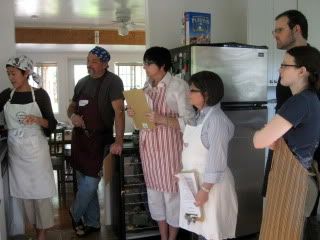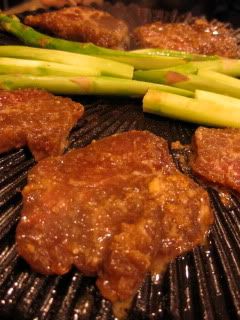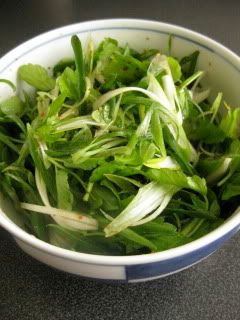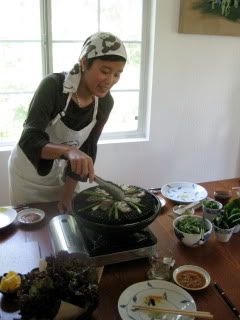
It was time for Sundubu Jjigae (Korean-style hot tofu stew) again...I was having big cravings for the dish, so I got the ingredients and just started cooking.
Then, I realized, I probably make it in a different way every time. I think, the last time, I sauteed the pork in the donabe first. But today, I made the broth first and added the main ingredients later. So, here's how I made it... tonight's version.
Tonight's Sundubu Jjigae with Donabe
Ingredients - 3 servings
3/4 lbs. pork belly slices, cut into bite-size pieces
1/2 teaspoon each salt and pepper
2 tablespoons sake
3.5 cups chicken stock
1/2 cup sake
1.5 tablespoons light color soy sauce (usukuchi shoyu)
2 tablespoons kochujan paste (Korean hot pepper paste)
2 teaspoons Korean red chili pepper flakes
1 package (about 14 oz) soft tofu
2-3 oz king oyster mushrooms
3-4 oz shimeji mushrooms
2-3 oz nira (Chinese chives), cut into 2" length
sliced scallion for topping
Procedure
1. Marinate the pork with salt, pepper, and the first 2 tablespoons of sake. Cover and let it rest in the fridge for 30 minutes.
2. In the donabe, bring the chicken stock to simmer over medium heat. Add the remaining (1/2 cup) sake and the soy sauce.
3. Add the kochujan paste and red chili pepper flakes to the donabe. Disolve the kochujan throughly in the broth.
4. Add the marinated pork to the broth.
5. When the pork is almost cooked through, add the tofu (break by hand) and mushrooms.
6. Simmer for 5-7 minutes. Add the nira, 1-2 minutes before turning off the heat.
7. Serve with sliced scallions, and rice on the side.
My home-style donabe Sundubu was ready. It looked so appetizing and smelled wonderful, too.
Yes, I put an egg in my sundubu! I kept it until the broth was half-way gone. Then, I added the rice to the broth and broke the egg yolk with the spoon. The gooey yolk coated the rice and it was just so delicious.
With the left over sundubu, next day, I made the sundubu ramen! I simply cooked the dry ramen noodles with the leftover broth.
I got to enjoy sundubu different ways over two meals. Wonderful.
Happy donabe life.


























































